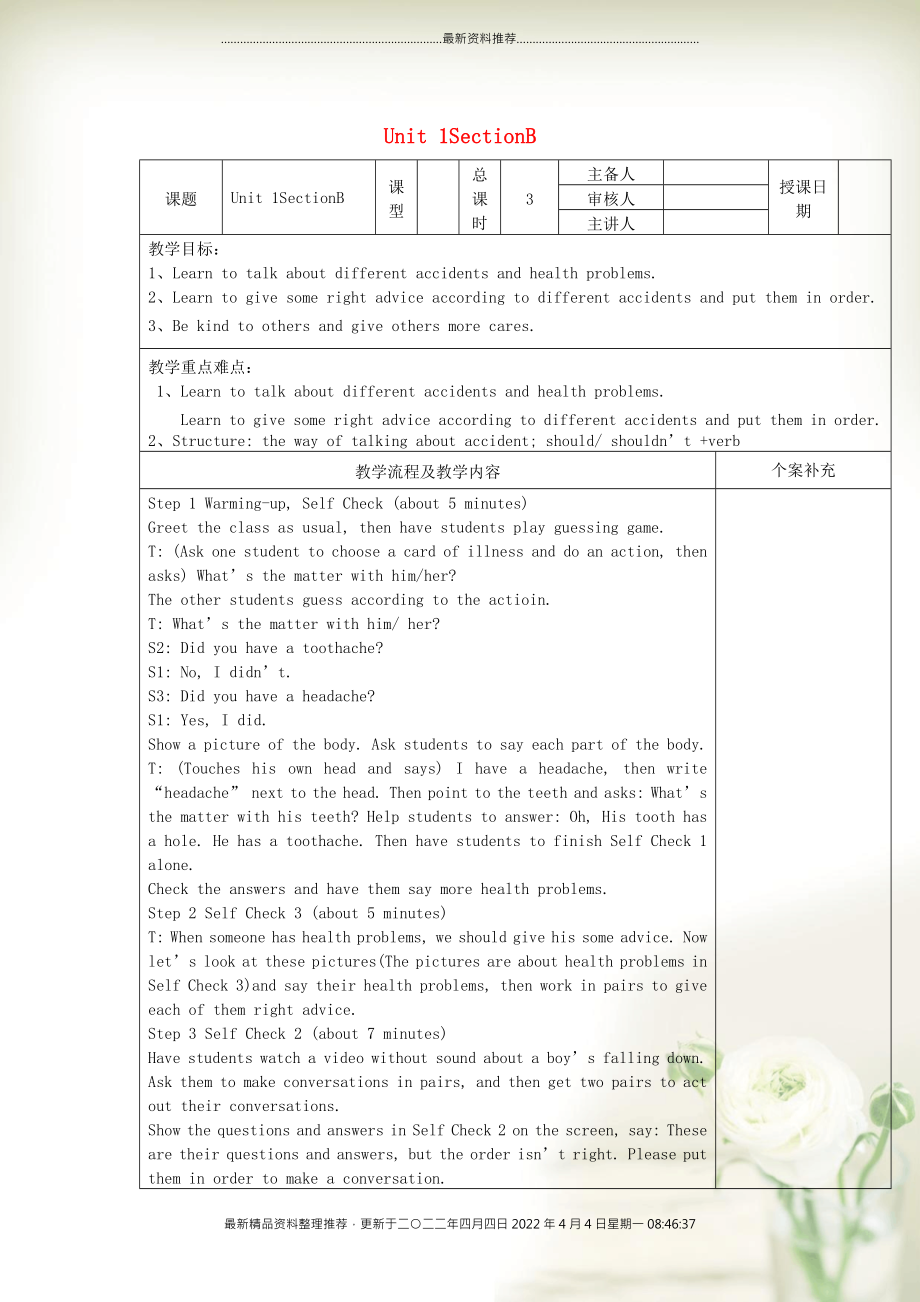《八年級(jí)英語(yǔ)下冊(cè)《Unit1 What’t the matter》(第三課時(shí))教案 (新版)人教新目標(biāo)版》由會(huì)員分享����,可在線閱讀����,更多相關(guān)《八年級(jí)英語(yǔ)下冊(cè)《Unit1 What’t the matter》(第三課時(shí))教案 (新版)人教新目標(biāo)版(2頁(yè)珍藏版)》請(qǐng)?jiān)谘b配圖網(wǎng)上搜索����。
1��、……………………………………………………………最新資料推薦…………………………………………………
Unit 1SectionB
課題
Unit 1SectionB
課型
總課時(shí)
3
主備人
授課日期
審核人
主講人
教學(xué)目標(biāo):
1��、Learn to talk about different accidents and health problems.
2�、Learn to give some right advice according to different accidents and put them in order.
3、Be ki
2�、nd to others and give others more cares.
教學(xué)重點(diǎn)難點(diǎn):
1、Learn to talk about different accidents and health problems.
Learn to give some right advice according to different accidents and put them in order.
2���、Structure: the way of talking about accident; should/ shouldn’t +verb
教學(xué)流程及教學(xué)內(nèi)容
個(gè)案補(bǔ)充
Step
3����、 1 Warming-up, Self Check (about 5 minutes)
Greet the class as usual, then have students play guessing game.
T: (Ask one student to choose a card of illness and do an action, then asks) What’s the matter with him/her?
The other students guess according to the actioin.
T: What’s the matter with h
4��、im/ her?
S2: Did you have a toothache?
S1: No, I didn’t.
S3: Did you have a headache?
S1: Yes, I did.
Show a picture of the body. Ask students to say each part of the body.
T: (Touches his own head and says) I have a headache, then write “headache” next to the head. Then point to the teeth and
5���、 asks: What’s the matter with his teeth? Help students to answer: Oh, His tooth has a hole. He has a toothache. Then have students to finish Self Check 1 alone.
Check the answers and have them say more health problems.
Step 2 Self Check 3 (about 5 minutes)
T: When someone has health problems, we
6���、should give his some advice. Now let’s look at these pictures(The pictures are about health problems in Self Check 3)and say their health problems, then work in pairs to give each of them right advice.
Step 3 Self Check 2 (about 7 minutes)
Have students watch a video without sound about a boy’s fa
7�、lling down. Ask them to make conversations in pairs, and then get two pairs to act out their conversations.
Show the questions and answers in Self Check 2 on the screen, say: These are their questions and answers, but the order isn’t right. Please put them in order to make a conversation.
Have stu
8����、dents work in pairs, and then have two pairs to say their answers. Finally play the video with sound, get students to check their answers.
Step 4 Presentation (about 9 minutes)
T: Here are some accidents that some people had. Please match the accidents with the pictures.
Ask students to learn new
9、 words and phrases by asking and answering.
Step 5 Listening practice (about 8 minutes)
Have students read the problems in 1b, then ask them to listen to the tape, find out what the two persons are talking about. Then play the tape a second time. This time, students choose the problems in 1b they
10�����、hear.
Have students read the treatments about the problems in 1c. First, ask students to guess the treatment of each problem they hear. Then have them listen again and fill in the chart in 1b.
Step 6 Practice (about 6 minutes)
First, have students read the conversation between the nurse and the t
11�����、eacher in 1d and tell them: “What happened?” is another way of saying “What’s the matter?” Then, have them make up new conversations in pairs by using the information in 1b and 1c. The teacher walks around and gives them some help if they need.
Ask some pairs to role-play their conversations.
Step
12��、 7Summary (about 3 minutes)
Ask one or two students to sup up what they learned in the class. Then teacher adds.
作業(yè)設(shè)計(jì):
Choose one of the problems or the accidents.
Frist, write down your advice, and then make a conversation.
板書設(shè)計(jì):
Section B 1a-1d
What’s the matter? =What happened?
He cut his finger.
What should he do?
He should put a bandage on it.
教學(xué)反思:
最新精品資料整理推薦�����,更新于二〇二二年四月四日2022年4月4日星期一08:46:37
 八年級(jí)英語(yǔ)下冊(cè)《Unit1 What’t the matter》(第三課時(shí))教案 (新版)人教新目標(biāo)版
八年級(jí)英語(yǔ)下冊(cè)《Unit1 What’t the matter》(第三課時(shí))教案 (新版)人教新目標(biāo)版

